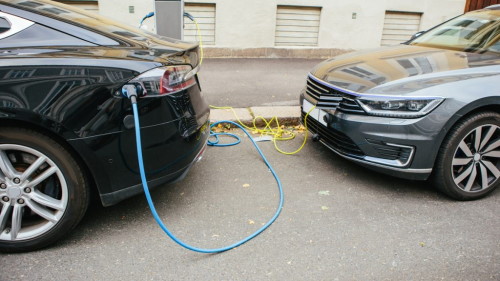'We have a really large challenge right now with making it easy for people to charge who live in apartments...'
Stephanie Terrell bought a used Nissan Leaf this fall and was excited to join the wave of drivers adopting electric vehicles to save on gas money and reduce her carbon footprint.
BREAKING: Eat This - Never Forget A Single Thing Again
But Terrell quickly encountered a bump in the road on her journey to clean driving: As a renter, she doesn’t have a private garage where she can power up overnight, and the public charging stations near her are often in use, with long wait times. On a recent day, the 23-year-old nearly ran out of power on the freeway because a public charging station she was counting on was busy.
“It was really scary and I was really worried I wasn’t going to make it, but luckily I made it here. Now I have to wait a couple hours to even use it because I can’t go any further,” she said while waiting at another station where a half-dozen EV drivers circled the parking lot, waiting their turn. “I feel better about it than buying gas, but there are problems I didn’t really anticipate.”
The great transition to electric vehicles is underway for single-family homeowners who can charge their cars at home, but for millions of renters like Terrell, access to charging remains a significant barrier. People who rent are also more likely to buy used EVs that have a lower range than the latest models, making reliable public charging even more critical for them.
Now, cities from Portland to Los Angeles to New York City are trying to come up with innovative public charging solutions as drivers string power cords across sidewalks, stand up their own private charging stations on city right-of-ways and line up at public facilities.
The Biden administration last month approved plans from all 50 states to roll out a network of high-speed chargers along interstate highways coast-to-coast using $5 billion in federal funding over the next five years. But states must wait to apply for an additional $2.5 billion in local grants to fill in charging gaps, including in low- and moderate-income areas of cities and in neighborhoods with limited private parking.
“We have a really large challenge right now with making it easy for people to charge who live in apartments,” said Jeff Allen, executive director of Forth, a nonprofit that advocates for equity in electric vehicle ownership and charging access.
The quickest place to charge is a fast charger, also known as DC Fast. Those charge a car in 20 to 45 minutes. But slower chargers which take several hours, known as Level 2, still outnumber DC fast chargers by nearly four to one, although their numbers are growing. Charging an electric vehicle on a standard residential outlet, or Level 1 charger, isn’t practical unless you drive little or can leave the car plugged in overnight, as many homeowners can.
Nationwide, there are about 120,000 public charging ports featuring Level 2 charging or above, and nearly 1.5 million electric vehicles registered in the U.S. — a ratio of just over one charging port per 12 cars nationally, according to the latest U.S. Department of Energy data from December 2021. But those chargers are not spread out evenly: In Arizona, for example, the ratio of electric vehicles to charging ports is 18 to one and in California, which has about 39% of the nation’s EVs, there are 16 zero-emissions vehicles for every charging port.
A briefing prepared for the U.S. Department of Energy last year by the Pacific Northwest National Laboratory forecasts a total of just under 19 million electric vehicles on the road by 2030, with a projected need for an extra 9.6 million charging stations to meet that demand.
In Los Angeles, for example, nearly one-quarter of all new vehicles registered in July were plug-in electric vehicles. The city estimates in the next 20 years, it will have to expand its distribution capacity anywhere from 25% to 50%, with roughly two-thirds of the new power demand coming from electric vehicles, said Yamen Nanne, manager of Los Angeles Department of Water and Power’s transportation electrification program.
Amid the boom, dense city neighborhoods are rapidly becoming pressure points in the patchy transition to electrification.
In Los Angeles, the city has installed over 500 pole-mounted electric vehicle chargers — 450 on street lights and about 50 of them on power poles — to meet the demand and has a goal of adding 200 EV pole chargers per year, Nanne said. The chargers are strategically installed in areas where there are apartment complexes or near amenities, he said.
The city currently has 18,000 commercial chargers — ones not in private homes — but only 4,367 are publicly accessible, Nanne said.
Mark Long, who lives in a floating home on Seattle’s Portage Bay, has leased or owned an EV since 2015 and charges at public stations — and sometimes charges on an outdoor outlet at a nearby office and pays them back for the cost.
“We have a small loading area but we all just park on the street,” said Long, who hopes to get one of the utility’s chargers installed for his floating community. “I’ve certainly been in a few situations where I’m down to 15, 14, 12 miles and … whatever I had planned, I’m just suddenly focused on getting a charge.”
TRENDING: Men Try This Tonight - You'll Never Need The Pill Again
Worldwide, by 2030, more than 6 million public chargers will be needed to support EV adoption at a rate that keeps international emissions goals within reach, according to a recent study by the International Council on Clean Transportation. As of this year, the Netherlands and Norway have already installed enough public charging to satisfy 45% and 38% of that demand, respectively, while the U.S. has less than 10% of it in place currently, according to the study, which looked at electrification in 17 nations and government entities that account for more than half of the world’s car sales.








